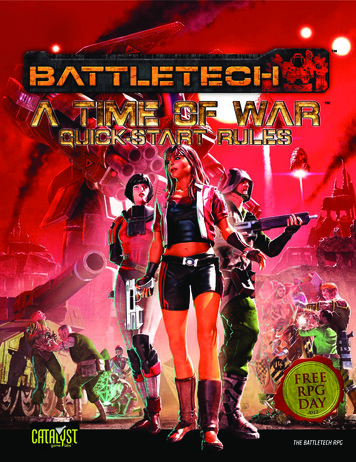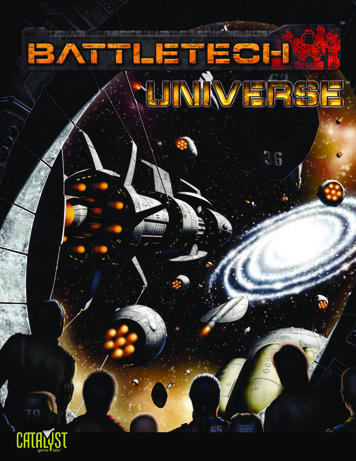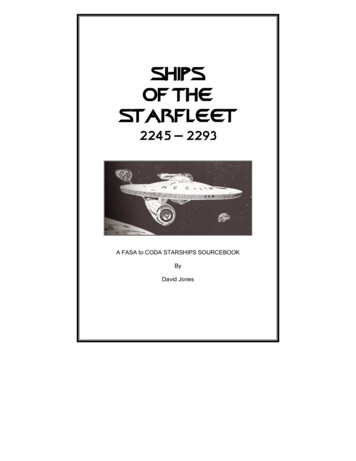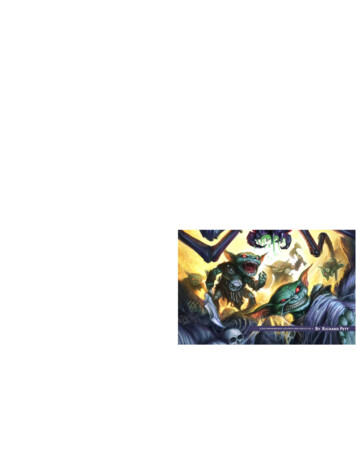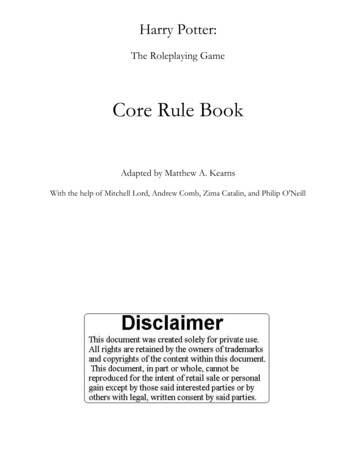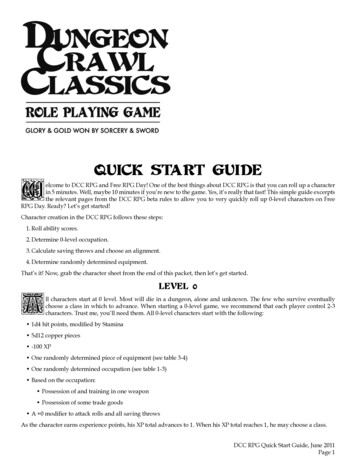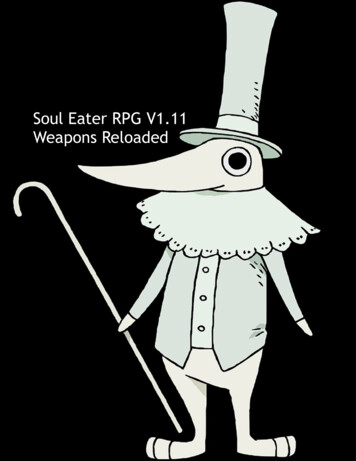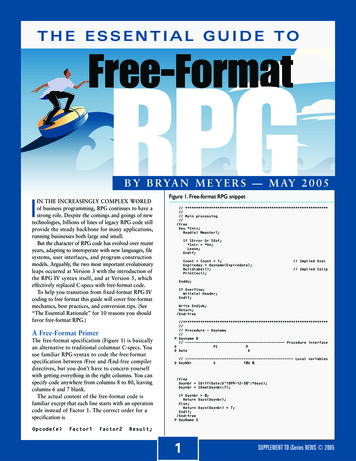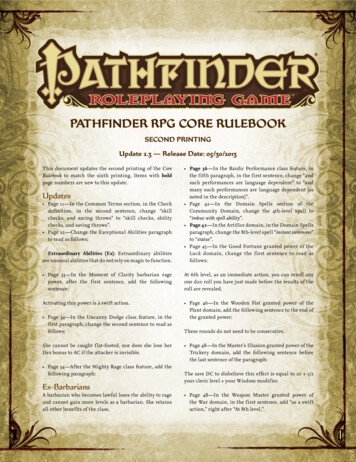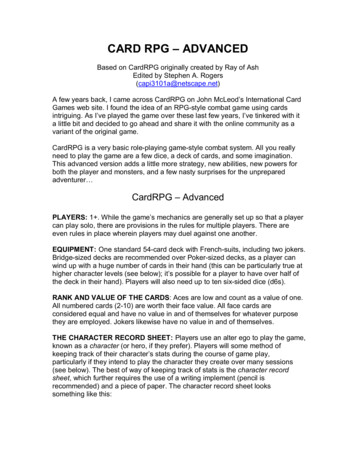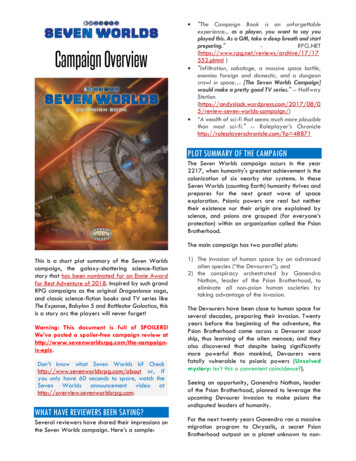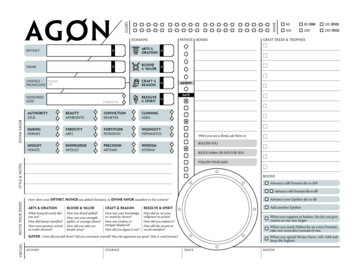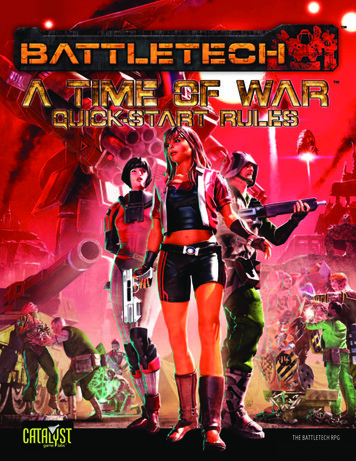
Transcription
THE BATTLETECH RPG
A technician’s job is never done.“This is the Inner Sphere, thousands of planets colonized byhuman-kind. Once, it was united under the Star League, but for thelast three hundred years, it has been consumed by savage wars .”It is a universe at war. Even as mankind reached out to commandthe stars, the human lust for conflict and conquest could not beovercome as easily as the distances of light years. Driven by thedream of one day ruling all of humanity, mighty empires formed,fell, and rose again. From the chaos of war arose the Star League,the pinnacle of human civilization, a Golden Age where a lastingpeace and time of prosperity seemed possible at last. But greed,ambition, and treachery combined to tear it all down once more,plunging all of the worlds humans called home into centuries ofsimmering conflict.Power over billions now rests in the hands of those who canclaim noble blood, or the heritage of elite warriors. Generations ofwarriors have done battle across countless worlds, fighting for adream long dead, perpetuating the cycle until few could imagineany other way. The most elite among these warriors—like modernday knights in the neo-feudal realms that now hold sway—are theMechWarriors, those who command the mightiest war machinesof the thirty-first century: BattleMechs.The BattleTech universe is a realm of perpetual war betweeninterstellar dynasties and feuding Clans. It is a realm wheremankind’s greatest enemy is mankind itself, where Byzantinepolitics and war to the knife go hand-in-hand. It is a universewhere the flags and governments change with regularity on theborder worlds, and high-minded ideals like “honor”, “glory”, and“freedom” are merely the catchphrases of ambitious warlords.It is a universe where life is cheap, but BattleMechs are not.Yeah. That’s the kind of crap they teach at those fancy Housemilitary academies. I know. I attended one. Since the fall of theoriginal Star League, they’ve been preaching the supremacy ofMechWarriors over all, but it’s total bunk. They seem to want toforget that every time one of those self-styled “new age knights”climbs into their ten-meter avatars of death, someone has todo the ground work before them, scouting the terrain ahead,clearing out any opposing spotters—or maybe even taking outsome of those self-important MechWarriors before they can dontheir cooling vests and shorts for the big fight ahead.Sure, the BattleMech may be the “king of the battlefield”, but noking on any world you can name can survive very long withoutthe people who really make the universe work. So don’t let thosehigh-and-mighty academy-trained ’Mech jocks fool you; at theend of the day—in any time of war—anybody can turn the tideof battle.Remember that, and you just may live to fight another day.A UNIVERSEIN FLAMES!The year is 3077. The Word of Blake Jihad now raging is justthe latest in a long, tragic line of star-spanning wars that hasconsumed mankind since he first ventured into the infiniteblackness of space. For centuries, the Great Houses of the InnerSphere—Davion, Kurita, Marik, Liao, and Steiner—have vied forsupremacy in the name of the fallen legacy of the Star League,while secretive sects like ComStar and the Word of Blake workedagainst them from behind the scenes. Even the arrival of themighty Clans—sophisticated techno-warriors evolved from theremnants of the great Star League’s regular army—failed to endthe cycle of conflict between the so-called Successor States.For a warrior like you, these are booming times, the stuff oflegend. You may fight for the banner of a House Lord as a soldier,or for a paycheck as a mercenary, or even for the thrill of thekill and the booty to be had as a pirate. You may do battle as aMechWarrior, the pilot of a one-man avatar of walking death—oras a high-flying aerospace fighter jock. You may be the covertoperative, skulking in the shadows, armed only with your witsand an untraceable sniper rifle—or a death-defying battlesuitpilot, braving instant death long enough to close in on an enemy’Mech and tear it open with your armored claws. Whether youare noble-born or of far more “common” blood, a universe inflames awaits youradventure. Choose yourloyalties—andyyyyyourweapons—carefully!
In a role-playing game (RPG, for short) a group of players gather toassume the roles of characters in an adventure directed by anotherplayer dubbed the gamemaster (or GM, for short). The gamemastermanages the action of the story and controls the opposition (often inthe form of non-player characters—NPCs, for short), as well as providingthe props, the setting, and any other situations or obstacles the players’characters may encounter. Together with the gamemaster, the playerscreate an intense and interesting adventure for their characters toresolve (if they can).The player characters (PCs) in A Time of War are operatives or warriorsfrom one of the many factions who constantly struggle for dominancein the BattleTech universe. The statistics and information needed to runthese characters effectively are noted on each character’s CharacterRecord Sheet.During the course of the game, the GM will describe the events andsurroundings to the other players, while those players willattempt to navigate their characters throughthe adventure. Periodically, the GM mayrequire a dice roll to resolve acharacter’s actions,using the rulesto determinethe success (orfailure) of theattempted actionbased on the dice roll result, the character’sstatistics, and any relevant circumstances.In a Time of War, the players roleplay within a war-torn BattleTechuniverse, where the fate of entire worlds can rest in the hands of thefew warriors who dare to seize their destiny.INTRODUCTIONWHAT IS AROLEPLAYINGGAME?We have specifically designed these quick-start rules (QSR) to dropyou straight into the fires of the thirty-first century in minutes! Readthrough these quick-start rules once. Then jump right into your ownadventures to practice what you’ve just learned.Additional helpful information can be found along the sides ofeach page, pointing out useful tips and tricks for both players andgamemasters. These sidebars will also provide numerous examples—using the pre-generated characters found at the end of these quickstart rules—to demonstrate how the rules actually work in game play.A TIME OF WARQUICK-START RULESDICEA Time of War uses a number of six-sideddice (D6s) to resolve actions—normallythrough Action Checks (p. 5). A typical actionwill require only two such dice per player, butsome Traits and other conditions may warrantthe addition of a third die to the roll. For easeof reference, once players have read the rules,we’ve included a dice icon next to any rule that requires adice roll.3
CHARACTERSA character in A Time of War is much like a character in a novel orfilm, except the player (or GM, for non-player characters) controlsthe character’s actions. Composed of a collection of attributesand skills, a character has the personality the controlling playerinjects into it.CHARACTER RECORD SHEETCharacter Record Sheets note the game statistics (numbers andinformation) that allow the personality that a player has injectedinto his character to interact within the framework of the gamesystem. In other words, as you move, interact with people andfight, all the information needed to resolve such actions is trackedon the Character Record Sheet. The Character Record Sheet alsotracks damage done to your character during combat.For these quick-start rules, pre-generated Character RecordSheets have been provided, with all their game statisticsalready noted, so players can immediately jump into the action.The Character Record Sheet includes an illustration and shortdescription of the character, as well as all the game statisticsneeded to play.As players read through the various rules, they may find thatglancing at one of the pre-generated Character Record Sheetsafter reading a particular section will enable them to betterunderstand how a given rule—such as attributes, skills and soon—works.ATTRIBUTESCharacters in A Time of War are described using three primarycategories of statistics. The first of these, Attributes, describes thecharacter’s raw physical and mental capabilities. Each characterpossesses eight Attribute values (called scores), which aredescribed as follows:STR (Strength): As its name implies, this Attribute measuresthe character’s raw muscle strength, affecting the amount ofweight he can lift and carry, and how much damage he candeliver in melee combat. The higher a character’s STR score, thestronger he is.BOD (Body): A character’s BOD Attribute describes how sturdyand “in shape” her physique is, measuring both the character’sendurance and her ability to withstand physical damage. Thehigher the character’s BOD, the longer she can manage to performstrenuous tasks or hold up in combat.RFL (Reflexes): The RFL Attribute identifies the character’sspeed and reaction time. The higher a character’s RFL score is, thefaster he can cover ground or react to threats.DEX (Dexterity): This Attribute describes the character’s finemotor control and accuracy, and is often vital to every actionfrom operating a computer to using ranged weapons in combat.Higher DEX scores define a character whose hands are steadierand more reliable when handling anything from a surgeon’sscalpel or soldering gun to a high-powered pistol.INT (Intelligence): As can be surmised, the INT Attributemeasures the character’s brainpower and ability to reason. HigherINT scores reflect sharper minds and better memory retention.WIL (Willpower): A character’s WIL Attribute defines not onlyhis abilityy to “think for himself”,, but also reflects on his abilityy tocommand others or even rally his nerves and his body againstATTRIBUTESiAttribute scores are most commonly used as modifiers inAttribute Checks—dice rolls used to determine a character’ssuccess based on a relevant physical Attribute. Since allmodifiers are added to a roll, and the goal of any ActionCheck roll is to equal or exceed a Target Number (TN), higherAttribute scores improve the character’s chances of success.Attribute scores in A Time of War tend to fall between 1 and8, with truly exceptional specimens occasionally reaching ashigh as 10 in some Attributes. An Attribute score of 5 or 6 thusreflects the level of an “average” person.fear and physical exhaustion in tense situations. Characters withhigher WIL scores can potentially maintain consciousness evenwhen injured beyond the body’s normal tolerances, or resist theeffects of intimidation and demoralization.CHA (Charisma): The essence of a character’s personalityand appeal, a character’s CHA Attribute measures how well herpersonality and manner can be used to influence those aroundher. While not exactly an indicator of physical beauty per se,higher CHA scores indicate a character who is more appealing orinspiring to others.EDG (Edge): The EDG Attribute can be one of the character’smost powerful allies in gameplay. Representing raw luck, EDGpoints can be “burned” in gameplay to affect action rolls, or evenforce a re-roll to give the character a chance of success (or give anenemy the chance to fail) at a critical moment. Characters withhigher EDG scores have more luck on their side.TRAITSThe second defining category for a character, Traits reflectother characteristics that a character may possess that are notas easily quantified with scores like Attributes, but instead reflecta little “something extra”. Traits can be positive (beneficial to thecharacter), or negative (a handicap of some sort) in nature.Examples of typical positive Traits include Attractive (bestowsphysical beauty upon the character and can provide a boost tosocial skills), Combat Sense (which reflects an intuitive grasp ofcombat), Natural Aptitudes (granting a better-than-normal successrate with Skills), or Toughness (enables a character to withstanddamage better than another character of equal Attributes).Typical negative Traits include Compulsion (a personality quirkranging from simple bad habits to outright manias), Glass Jaw(unusual susceptibility to injury), Handicap (a physical or mentalimpairment), and Unlucky (a Trait that acts as a kind of “anti-EDG”against the character).There is a broad range of Traits available to characters in ATime of War, each of which possesses its own unique rules. Forthe purposes of these quick-start rules, these special rules will bebriefly described in the sample characters’ Character Sheets.SKILLSThe final defining category for a character in A Time of War isthe character’s list of Skills. A character’s Skills represent abilitiesshe has been trained to use effectively. In a typical A Time of Warroleplayingp y g session,, characters will use their Skills to resolveactions far more often than they will use their Attributes or Traits.
Traits are special-purpose characteristics that offer a rangeof extra character abilities beyond the Attributes and Skills—or can even serve as a potential plot hook. Many provide rulesthat are special to a given situation or are specific to a certainarea of expertise, but others can be even more far-reaching.It is ultimately up to the GM to decide if and when acharacter’s Trait is relevant enough to have an effect on asituation. For example, a character with the Attractive Traitmay get far in trying to seduce a receptive NPC by bankingon her looks and flowery speech, but if the subject is blind(or has a peculiar aversion to pretty girls), the GM could rulethat the Attractive Trait is negated by the subject’s blindness,or the subject’s hostility toward pretty girls could produce anopposite effect on the would-be seductress’ efforts.The Skills used by characters in A Time of War receive fourprimary statistics: Target Number, Skill Complexity, LinkedAttributes, and Skill Level.Target NumberThe Target Number (TN) for a Skill is a numerical value thatidentifies the base value any roll using tha
MechWarrior, the pilot of a one-man avatar of walking death—or as a high-fl ying aerospace fi ghter jock. You may be the covert operative, skulking in the shadows, armed only with your wits and an untraceable sniper rifl e—or a death-defying battlesuit pilot, braving instant death long enough to close in on an enemy ’Mech and tear it open with your armored claws. Whether you are noble .
